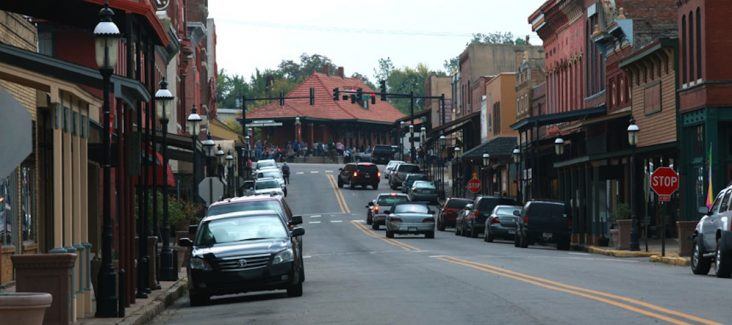Van Buren Original group holds first public discussion about downtown revitalization
by May 10, 2016 7:14 pm 849 views

Downtown Van Buren
Van Buren Original (VBO) held its kickoff meeting in the second floor of the King Opera House downtown on Tuesday (May 10), identifying two key opportunities to revitalize the city’s historic downtown district: spreading the word about the “wet county” initiative aimed for the November ballot and immediately moving forward with “pop-up shops” as a way of illustrating the area’s business potential.
Carole Williamson of the Municipal Auditorium Commission which oversees the King Opera House, broached the “dry-versus-wet” subject, stating that until liquor sales come to Crawford County “we won’t get the restaurants here that we need, and people are not going to come here. It’s going to be a great hindrance to us.”
She continued: “People interested in revitalization of downtown should help other people understand how important that particular situation is.”
There are two groups trying to spread the word throughout the area. Keep Dollars in Crawford County commissioned a recent study from the University of Arkansas to demonstrate the economic impact that open liquor sales would have on the region.
According to that study, overall economic impact for the first year Crawford County begins selling alcohol would be over $5.8 million dollars, with an estimated $15.5 million dollars in total sales. This would also result in $585,000 of tax revenue and create up to 76 jobs. The group was started by attorney Kevin Holmes, who filed paperwork Feb. 3 with the Arkansas Ethics Commission (AEC). He also hired a company to gather the 12,000 signatures needed by July to send this initiative to November’s ballot.
The second group – Stay Dry, Stay Safe – has spent around $84,000 to oppose that effort, largely in the form of advertising, signage and consulting according to its latest financial report filed with the AEC.
VBO organizer Rusty Myers acknowledged that “it’s a challenge when you have a dry county, though you can have liquor sales through a private club license.” Regardless, he said, VBO would be moving forward.
“There are things we can do. Economically we’re in a good situation. This is not a downer economy area, and there are many things we can leverage,” Myers said.
POP-UP SHOPS
One of those “achievable” things recommended by Galen Hunter and Tim Varner of MAHG Architecture – VBO consultants – was the “pop-up shop” concept, which is designed to be a temporary business utilizing a small portion of downtown real estate (think two adjoining parking spaces or the gaps between buildings).
As described by BetterBlock.org, a pop-up shop might include “a cafe with outdoor seating to highlight the ability to re-utilize the space given to cars.” It could also take the form of a children’s art studio, a flower/gift market with local crafts, a book-drive collection or a mini-outdoor bookstore.
Maryl Koeth, director of Van Buren Advertising and Promotion (A&P), liked this idea because “it’s temporary, inexpensive, and it serves several purposes with the main purpose important to our efforts being that it speaks to the people of Van Buren and shows them we are making positive changes and making the Main Street area somewhere they want to spend time.”
“That is a very inexpensive change we can implement quickly,” she added.
OCCUPANCY RATE, RESTAURANTS, AND PLANNING
Where Hunter and Varner see Van Buren as having an advantage over other downtown revitalization efforts is the fact “it already has a lot going for it,” Hunter said, adding that the city will not be “starting from scratch” with a relatively high occupancy rate in its buildings. There is now 82% occupancy, though they “may not necessarily be with the types of tenants you want.”
“Still, it’s a starting point,” he said.
Varner said there should be a greater restaurant presence since the makeup of that category is just 3% (five buildings, one being a candy shop). When asked to describe the ideal type of restaurant for downtown Van Buren, Varner said it should be “a local staple, not necessarily a global chain, but something already successful in the region like a Calico County or a Fort Smith-branded restaurant looking at a potential satellite location.”
From an urban planning perspective, Hunter and Varner emphasized the advantages of “form-based coding” over the traditional zoning Fort Smith uses. With form-based coding, Varner said, the goal is to “define an experience for visitors.”
“It’s the form of the building that matters most rather than what you’re allowing inside,” he said.
